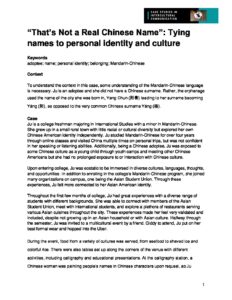“That’s Not a Real Chinese Name”: Tying names to personal identity and culture
Keywords
adoptee; name; personal identity; belonging; Mandarin-Chinese
Context
To understand the context in this case, some understanding of the Mandarin-Chinese language is necessary. Ju is an adoptee and she did not have a Chinese surname. Rather, the orphanage used the name of the city she was born in, Yang Chun (阳春) leading to her surname becoming Yáng (阳), as opposed to the very common Chinese surname Yáng (杨).
Case
Ju is a college freshman majoring in International Studies with a minor in Mandarin-Chinese. She grew up in a small rural town with little racial or cultural diversity but explored her own Chinese American identity independently. Ju studied Mandarin-Chinese for over four years through online classes and visited China multiple times on personal trips, but was not confident in her speaking or listening abilities. Additionally, being a Chinese adoptee, Ju was exposed to some Chinese culture as a young child through youth camps and meeting other Chinese Americans but she had no prolonged exposure to or interaction with Chinese culture.
Upon entering college, Ju was ecstatic to be immersed in diverse cultures, languages, thoughts, and opportunities. In addition to enrolling in the college’s Mandarin-Chinese program, she joined many organizations on campus, one being the Asian Student Union. Through these experiences, Ju felt more connected to her Asian American identity.
Throughout the first few months of college, Ju had great experiences with a diverse range of students with different backgrounds. She was able to connect with members of the Asian Student Union, meet with international students, and explore a plethora of restaurants serving various Asian cuisines throughout the city. These experiences made her feel very validated and included, despite not growing up in an Asian household or with Asian culture. Halfway through the semester, Ju was invited to a multicultural event by a friend. Giddy to attend, Ju put on her best formal wear and hopped into the Uber.
During the event, food from a variety of cultures was served, from seafood to shaved ice and colorful rice. There were also tables set up along the corners of the venue with different activities, including calligraphy and educational presentations. At the calligraphy station, a Chinese woman was painting people’s names in Chinese characters upon request, so Ju stepped up asking for her Chinese name to be painted. Ju explained the characters used to write her surname, Yáng (阳), the name given to Ju by her orphanage, then waited with excitement to see them appear in beautiful brush strokes. But, the calligrapher paused and exclaimed “That’s not a Chinese name. Do you mean Yáng (杨)?” As Ju continued to insist on using her given name, the calligrapher went silent and wrote the incorrect Yáng (杨). Understandably, the calligrapher was confused and believed that Ju was referring to the wrong character, as meeting an adoptee with this name was not common.
This interaction was extremely distressing to Ju. She felt greatly invalidated, especially after yearning to feel accepted and validated by the Asian American community for so long. But, she also did not want to disrespect the calligrapher. And while Ju was well aware that Yáng (阳) was not a Chinese surname, it was the name her name which held deep meaning and a sense of personal connection to the little knowledge she had about her birth country. In previous instances, Ju was told that her name “sounded Japanese” or was “written with strange characters,” so while this encounter was not isolated nor malicious, it was another reminder that she will always be viewed as an outsider by her birth culture and community.
Discussion Questions
As you consider this case, discuss:
- How is personal identity tied to one’s name?
- How does language affect one’s perception of personal identity?
- Is it possible for Ju to validate her own identity while also respecting the calligrapher? If so, how?
- What is an appropriate way to ask someone about the history or meaning of their name?
- How can one be more inclusive of different names and identities?
Additional Resources
Additional recommended resources to explore the central themes in this case are available.
- Getting it right; why pronouncing names correctly matters – Ted Talk
- Chinese orphanages and children’s names – Pinyin News
- How Do Chinese Names Work?
- Can You Say My Name? On Names, Culture & Identity
- Cultural and Ethnic Influences on Baby Names
Corresponding Author
Tomko, Mei, American University, Washington, DC, USA, Email: mt3393a@student.american.edu


